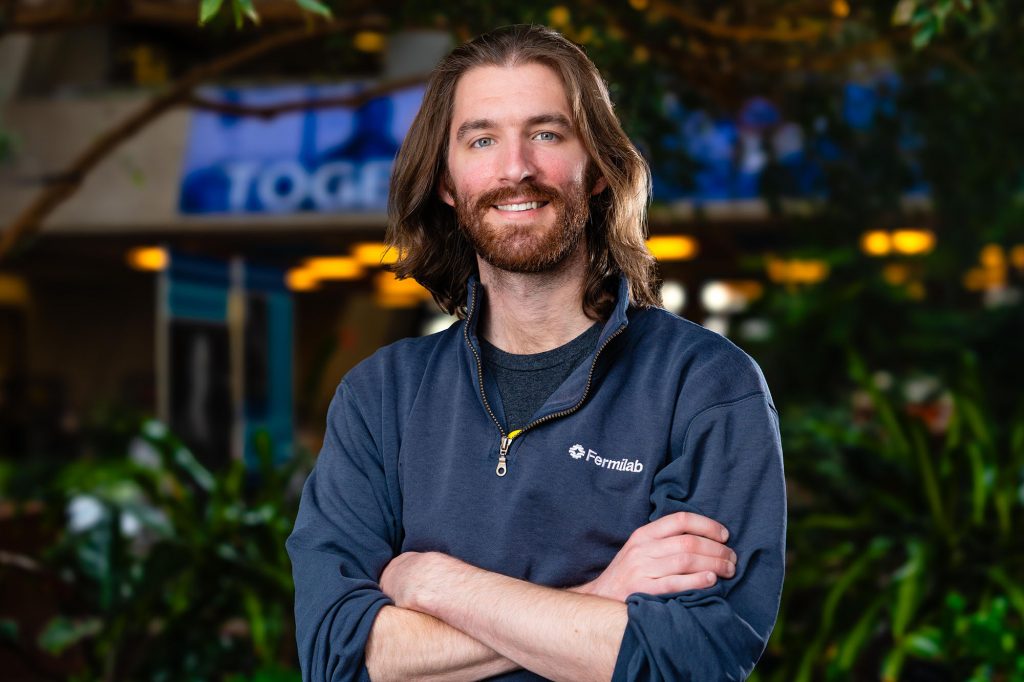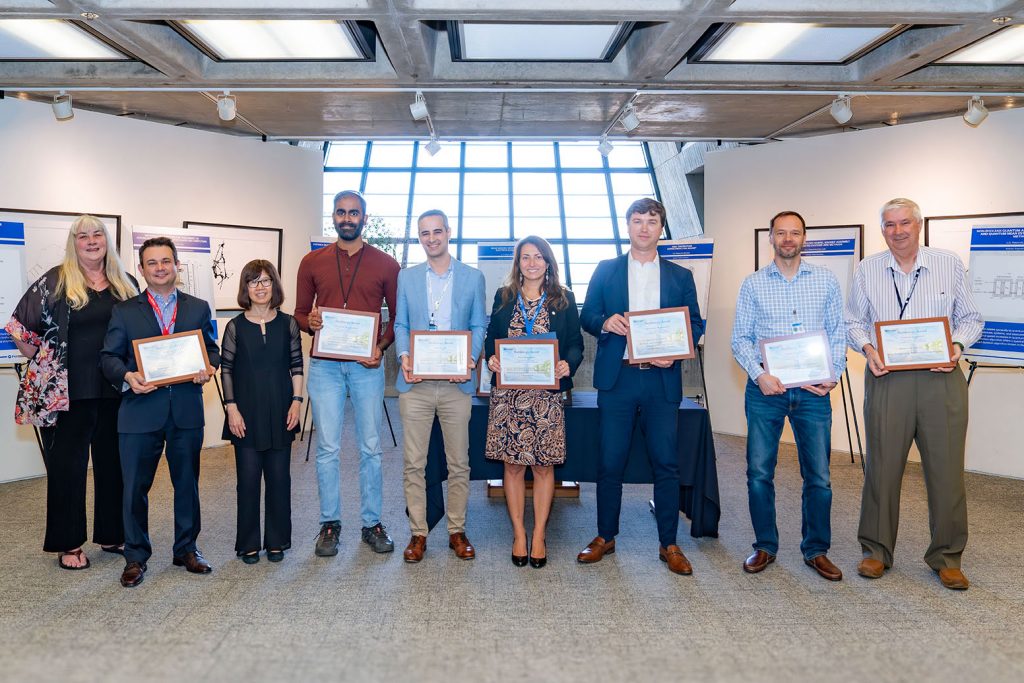
What do you do at Fermilab?
I’m a postdoctoral research associate working at Fermilab with the Quantum Science Center, which is hosted by Oak Ridge National Laboratory. My work focuses on studying the impacts of particles on superconducting quantum devices to help researchers make better technologies for quantum computing while also repurposing that technology for dark matter searches.
These technologies are incredibly sensitive to environmental disturbances and this sensitivity could help us detect low-energy interactions, like those that might come from dark matter particles. We build detectors to try and spot dark matter directly by observing small energy depositions. One of the lowest-energy signals we can detect in general are from phonons — tiny vibrations that ripple through the detector when a particle hits the materials within. Phonons are a nuisance for quantum computing, however they might be a useful signal for dark matter detection.
It’s an exciting overlap between two fields — quantum information and particle physics.
How long have you worked at Fermilab?
I’ve been at Fermilab for two and a half years. In that time, I’ve shifted into a different field. Previously, I wasn’t working with superconductors or qubits. My background was in the LUX-ZEPLIN experiment, which uses an approximately 7-ton tank of liquid xenon to search for dark matter by observing light and ionization caused by particle collisions. I helped design and build parts of that experiment.
What is the most challenging part of your work?
One of the toughest parts of this work is that we’re not tied to a specific experiment. That gives us freedom, but it also makes planning harder. The development cycle — designing a device, building it, testing it, refining it — can take months. The devices are also very complex, requiring many different kinds of tests and studies.
There’s a huge space of possibilities we’re exploring for sensing phonons. We’re constantly refining our direction based on what we learn. Being new to this field, we’re asking lots of questions, which is exciting, but it can also be overwhelming. Choosing the most impactful path isn’t always obvious.
What is the most rewarding part of the work you do at Fermilab?
It’s most rewarding to work in the collaborative space between quantum information science and particle physics. Researchers in both fields have realized they share challenges when it comes to understanding the microphysics of quantum devices. By studying the materials and how they respond on a very small scale, we can improve both dark matter detection and quantum computing.
We’re building knowledge from the ground up — figuring out how materials behave, how detectors respond and what we can do better. It’s exciting to work so close to the hardware and to be in a position where we can share insights between these two fields.
What do you do for fun outside of work?
Before moving to the Chicago area, I lived in California and got really into surfing — it was like a religion for me during my last nine months there. Now, I do social dancing. I enjoy swing dancing, waltz and Latin styles, and I usually go to a swing dance event once a month. I like learning and trying new moves, and I enjoy the connection you get with your dance partner. It’s about having fun, feeling cool and making it look cool too.
Fermi National Accelerator Laboratory is supported by the Office of Science of the U.S. Department of Energy. The Office of Science is the single largest supporter of basic research in the physical sciences in the United States and is working to address some of the most pressing challenges of our time. For more information, please visit science.energy.gov.
Researchers at the U.S. Department of Energy’s Fermi National Accelerator Laboratory were recognized this April for their cutting-edge contributions to science and technology, earning six U.S. patents in 2024.
The annual Inventor Recognition Ceremony celebrated these achievements, spotlighting the transformative potential of Fermilab-developed innovations and the lab’s mission to connect its technological breakthroughs with private-sector partners — a key step in boosting U.S. economic competitiveness.
Cherri Schmidt, who recently retired as head of Fermilab’s Office of Partnerships and Technology Transfer, emphasized the real-world impact of these inventions.
“At Fermilab, ideas matter — not just in theory, but in impact,” Schmidt said. “When you develop a novel method, a piece of hardware, a unique process — you are not just solving a problem. You’re contributing to the advancement of science, to the national interest, and sometimes, even to industries and technologies that haven’t imagined your solution.”

Backed by world-class facilities and deep scientific expertise, Fermilab researchers developed several breakthrough technologies now protected by patents. The honorees and their patented innovations include:
Anna Grassellino, Sam Posen and Alexander Romanenko
- Methods and Systems for Treatment of Superconducting Materials to Improve Low Field Performance: Grassellino, Posen and Romanenko patented a method improving superconducting radio frequency cavities. This enhances performance by removing a thin layer that naturally forms on the inner surface of SRF cavities. The result is a dramatic improvement in the cavities’ quality factor that enables longer times for quantum states, demonstrating that SRF cavities are well suited for quantum computing, quantum memory, and next-generation accelerator technologies.
Robert Kephart and Aaron Sauers
- Beam Bending Snout for Mobile Electron Accelerators: Kephart’s and Sauers’ invention enables precise, on-site surface treatments and fabrication using mobile electron beams. Their work opens new possibilities for infrastructure repair, roadway strengthening and large-scale additive manufacturing.
- Infrastructure-Scale Additive Manufacturing Using Mobile Electron Accelerators: Kephart’s and Sauers’ additional patent uses the technology in the first patent to enable large-scale additive manufacturing with electron-beam accelerators. Its applications include on-site fabrication or repair of infrastructure like roads by cross-linking polymers, bitumen or other materials, all while the accelerator is mounted on a mobile platform like a truck.
Vadim Kashikhin
- Conductor on Molded Barrel Magnet Assembly and Associated Systems and Methods: Kashikhin’s COMB magnet design uses advanced 3D printing to create a custom support structure that precisely holds superconducting cables in place, reducing stress on the materials and simplifying construction — all of which are essential for building the next generation of accelerators or upgrading existing ones. Kashikhin’s design will make cutting-edge particle physics experiments stronger and more efficient.
Vladimir Kashikhin
- High-Temperature Superconducting Magnet: Kashikhin’s design creates highly stable magnetic fields without the need to keep a magnet constantly powered. The design uses a special type of coil made from stacked high-temperature superconducting tapes. This marks a significant advancement, producing magnets with long-lasting magnetic fields essential for particle accelerators and magnetic levitation systems like maglev trains.
Roger Milholland
- Portable Self-Contained Pressure Testing Manifold and Associated Methods: With flexible hoses, multiple pressure gauges, safety valves and clearly marked controls, Milholland’s design enables technicians to gradually test pressure, check for leaks and easily switch between air or water as the testing medium. The setup simplifies compliance with American Society of Mechanical Engineers standards while keeping everything organized in a sturdy case and ready to go for use in the lab or in the field.
Prasanth Shayamsundar
- Non-Boolean Quantum Amplitude Amplification and Quantum Mean Estimation Systems and Methods: Shayamsundar developed a quantum algorithm that radically speeds up certain types of computations, completing tasks in minutes with the help of quantum computers that, by contrast, would take years for a traditional computer to complete. It can help scientists spot patterns — subtle deviations or meaningful averages — within the complexity of the system they’re studying.
“These patents are a testament to the creativity and dedication of our scientists and engineers,” said Fermilab interim director Young-Kee Kim. “They reflect the laboratory’s commitment to advancing discovery while delivering technologies that make a positive difference in the world.”
Fermi National Accelerator Laboratory is supported by the Office of Science of the U.S. Department of Energy. The Office of Science is the single largest supporter of basic research in the physical sciences in the United States and is working to address some of the most pressing challenges of our time. For more information, please visit science.energy.gov.
